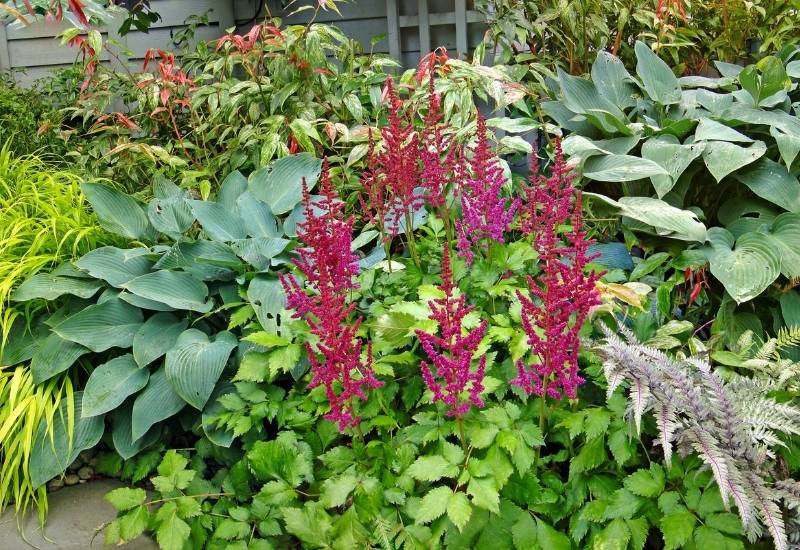
We all scratch our heads when we have a shady garden where the Sun does not shine all day, or not even all morning: “What shrubs could I grow there?”
Shady places can be a problem for gardens, especially when it comes to growing shrubs underneath a shade tree. However, there are plenty of shade shrubs that will grow quite happily even without a lot of direct sunlight.
While, most shrubs love brightly lit positions, but many shade-loving evergreen and deciduous even flowering varieties will do just fine, and they add to the freshness of that corner in the shade.
Talking of shrubs that grow where sunlight is scarce, only a few of them tolerate full shade (less than 3 hours of bright light a day) but many more like partial or dappled shade (between 3 and 6 hours).
Because each of these shade situations presents particular challenges, choosing shrubs best-suited to the environment requires smart gardening.
In this article I’m going to guide you through all a gardener need to know about poor light conditions, shrubs that like them and some of the easy to grow shrubs to plant in your landscape to fill even the shadiest corner with plenty of color.
30 Beautiful Shade Loving Shrubs

Shade And Shrubs: A Keynote
We can find many shrubs that like shady places because many grow in the underbrush in Nature. Just take a walk in a wild woodland area and you will see that all the space from the canopy of trees to their roots is filled in with bushy plants of all sorts, including climbers, flowering varieties, those that drop their leaves in winter and those that keep them.
What We Mean by “Shade” in Gardening
Gardeners don’t mean “total darkness” by shade, they mean “poorly lit”. The definition of “full Sun” may be ambiguous, but for your clarity, it does not mean “direct sunlight” but simply “bright sunlight” – even and often indirect.
If you take this as your yardstick, you will find that few places are really in full shade. Take this word as meaning what you get “under thick canopy or under a roof”; if light gets through the leaves, it already is “dappled shade”, and it counts as “partial shade”.
What is more, you only need a morning or afternoon of bright light to call the spot “in full Sun”. 6 hours or more to be surgical and scientific. That spot that gets the light in the morning but not after noon is in full Sun!
When it is less that this time, we start talking about shade.
Full Shade, Partial Shade, Dappled Shade and Light Shade
You can find these terms in gardening books and articles, the key ones are “full shade” and “partial shade”.
They mean “less than 3 hours of bright light a day on average” and “between 6 and 3 hours of bright light a day in average”.
“Dappled shade” and “light shade” are more specific and you will only find it when we talk about shade loving plants, like our shrubs.
They show specific preferences. But you will not find varieties that like only light shade in this article; they all need to grow in partial shade at least!
Flowering, Climbing, Evergreen and Deciduous Shade Loving Shrubs
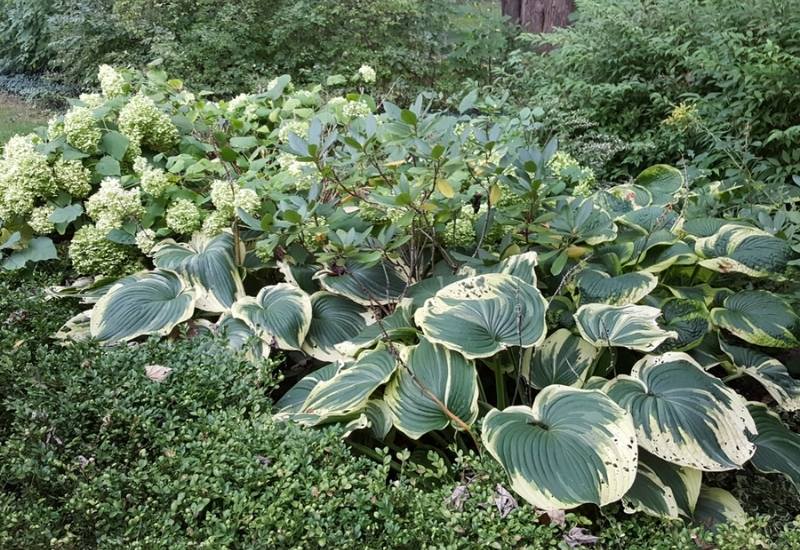
A few words on our four categories of shade loving shrubs; some varieties cross over, especially with the flowering group.
But while hydrangea has big, showy inflorescences and we love it for these especially, red tip photinia too has flowers, but they are small and inconspicuous, so we put it with the evergreen varieties.
It makes gardening sense to ignore an aspect which is not the most relevant to our choice of shrub to grow in partial shade or even full shade.
Shade Loving Shrubs and Heat
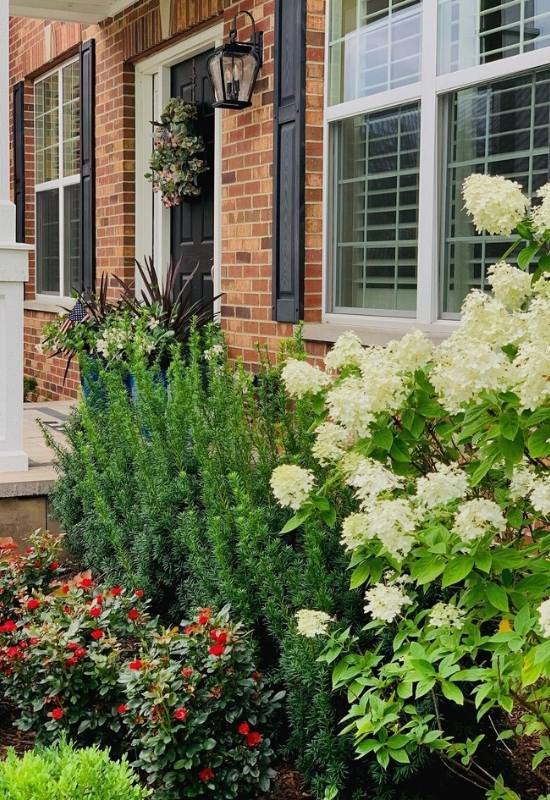
A final word is due to heat and shade. Some shrubs, like roses, are not heat tolerant; these will enjoy bright light in the morning but they may need some fresh shade in the afternoon, when temperatures rise.
Equally, fresh loving plants may prefer a place in partial shade rather than full sunlight in hot countries, even if they would normally love “full Sun”.
This means that if you live in a high USDA zone, like 9 or 10 and above, you may grow more shrubs and plants in those poorly lit places that give you headaches.
And now, without further ado, get a cup of tea and enjoy our great selection of shade loving shrubs!
Shade Loving Flowering Shrubs
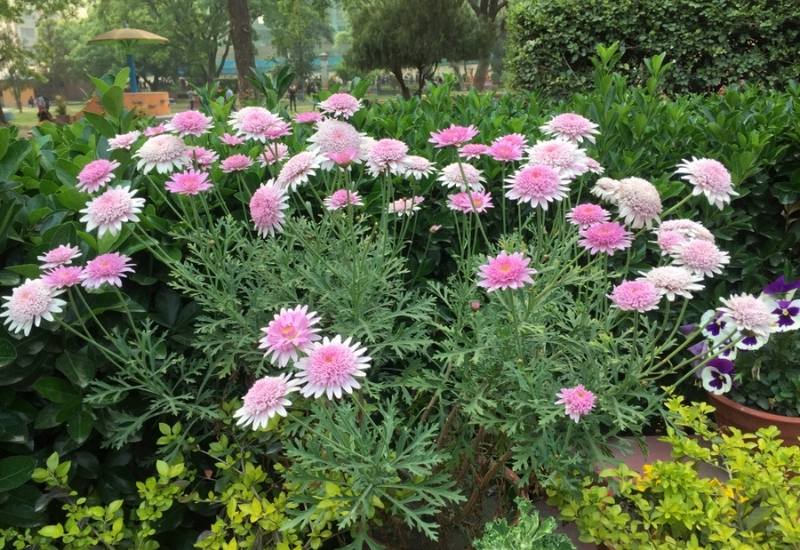
It’s hard to grow flowering plants in partial or even more in full shade, that’s why most of the shrubs we have chosen fall into this category.
Getting blooms in a poorly lit area is a great achievement and it can quite literally change the whole look and feel of your garden, terrace, or green haven.
And you will be surprised to find amazing, brightly colored beauties among them, even some roses!
1: Hydrangea (Hydrangea macrophylla)
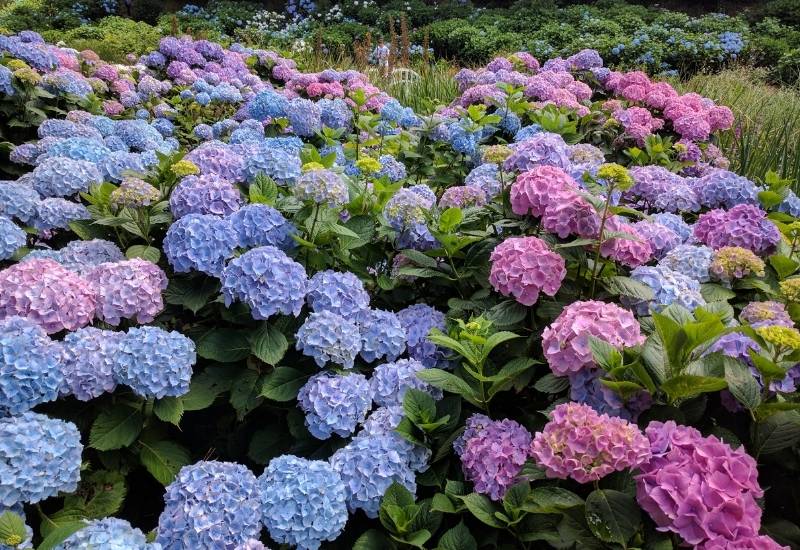
Hydrangea is the “queen of dappled shade”; its amazing large inflorescences bloom perfectly well in partial shade, they add vibrancy galore to fresh spots under trees and they can be of so many different colors, along the white to purple range.
Some have very delicate “old world” shades, like the pink “Emotions” or the classic and award winning cream “Annabelle”; others have very strong tints, like the bright blue “Glory Blue” or the deep purple “Merrit’s Supreme”.
This way, you can have a series of different effects to accompany or contrast the freshness of the place.
2: African Scurf Pea (Psoralea pinnata)
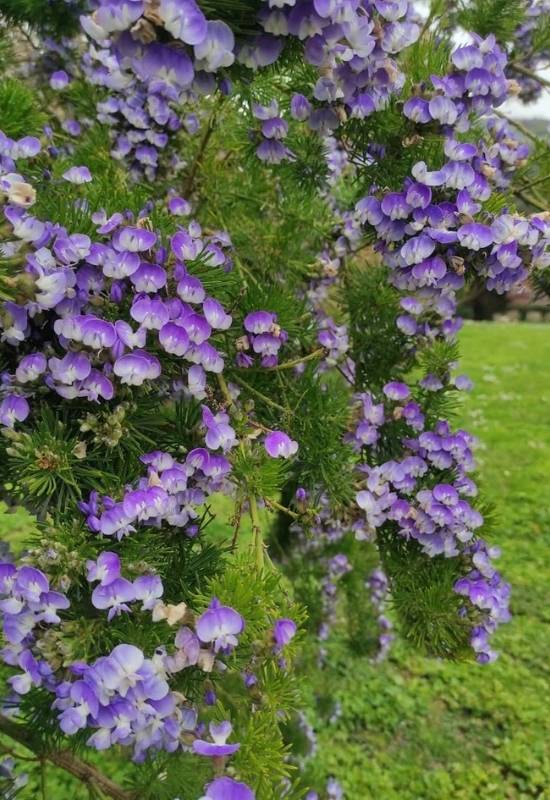
African scurf pea will give you lovely lilac blooms with the unique shape of pea blooms, with keel, wings and banner.
But unlike her close relatives, she is a lovely shrub, which you can even prune into a small tree if you want a more formal design.
And you may need to prune it regularly, because it will not keep a full and regular appearance. The foliage is very beautiful and finely texture, reminiscent of that of rosemary or a conifer, and the blooms are very generous and they will appear late in the season at the end of the branches.
3: Sweetshrub (Calycanthus occidentalis)
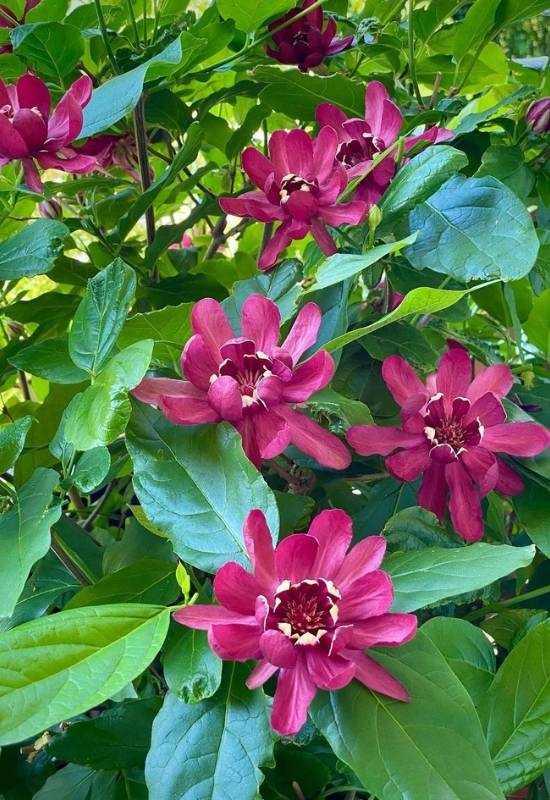
Sweetshrub will fill your shady spot with showy, brightly colored cupped flowers with fleshy spoon shaped petals. They look a bit like the blooms of magnolia.
These can be purple, white, or variegated, and they can reach 4 inches in diameter (10 cm). They also have a pleasant aroma, to add to your garden.
They will appear on top of the bright, glossy, mid green foliage, with broad and lush looking leaves.
The foliage will turn yellow in fall, for a final blush of light and color. Finally, if you crush the bark, you also get a very nice perfume.
4: Camellia (Camellia sinensis)
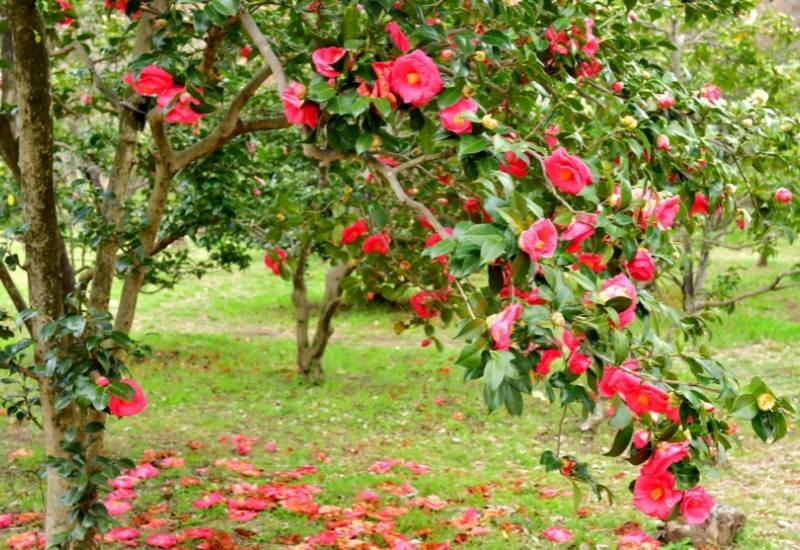
Camellia is a star of shady gardens; it really loves them. Its white, pink or red flowers are rose like and very elegant and showy at the same time. The glossy evergreen foliage of this slow growing shrub is in itself of great decorative value.
It is not an easy plant to grow though; it is high maintenance and it requires acidic soil. But if you have the right conditions and time, it is a pity not to grow one of this famous flowers.
No other plant can give you the same sense of peace and quiet, of English country garden as camellia does. And did you know you can make tea with its leaves?
5: Chinese Fringe Flower (Loropetalum chiniense)
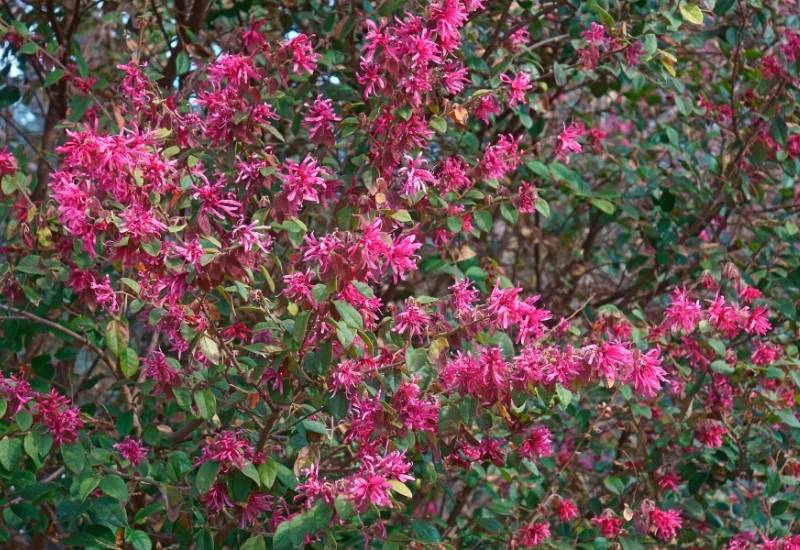
Chinese fringe flower is s a medium sized compact shrub which grows and looks well in partial shade. The blooms look like spiders with long and string like petals, and they can be white or deep red.
The blooms will appear very early in the season, when it’s hard to get color in a garden. They are quite abundant, and the evergreen glossy elliptical leaves of a deep green shade sets them off perfectly well.
It will mix in well in borders as well, and we all know the big problem of the border without full Sun! It is a low maintenance plant as well, and one that you can use to “set the scene” of your shady corner without stealing the show.
6: Rhododendron and Azalea (Rhododendron spp.)
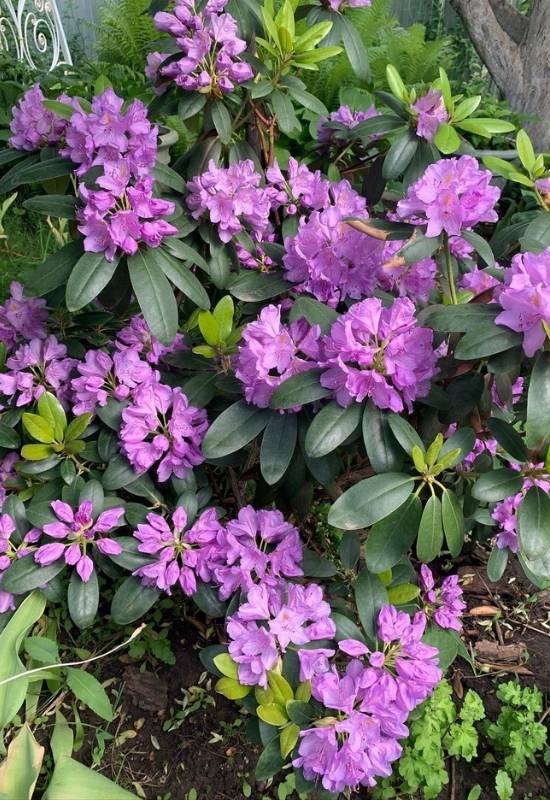
Azaleas and rhododendrons are miracle bloomers you can grow very well in shady spots. In fact they love to grow under trees, and they will fill the space with their impressive flowers.
The range of colors is huge, from white to purple via pink, yellow, orange, red and violet. The spectacle of a rhododendron blossom is breathtaking, and hard to miss.
These plants come in small and big sizes, so you can have them in all sorts of gardens and even in containers. They too love acidic soil, though, and if yours is alkaline, maybe a nice pot is the best solution.
7: Swamp Doghobble (Eubotrys racemosus)
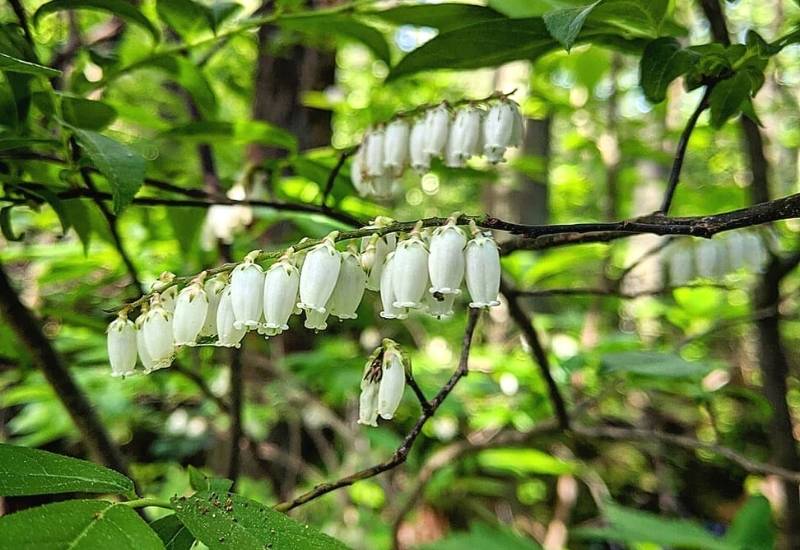
Swamp doghobble is the ideal shrub if the spot you have in mind is not just shades, but swampy too. So it solves a very difficult gardening problem for you.
And it does so with long clusters of bell shaped, fragrant, nodding flowers that arch out from the foliage all through the warm season.
The blooms will also attract bees and butterflies. The light green elliptical leaves are beautiful too, growing on the glossy branches. This medium sized bush has a prostrate habit, which looks great next to ponds and rivers.
8: Gardenia (Gardenia jasminoides)
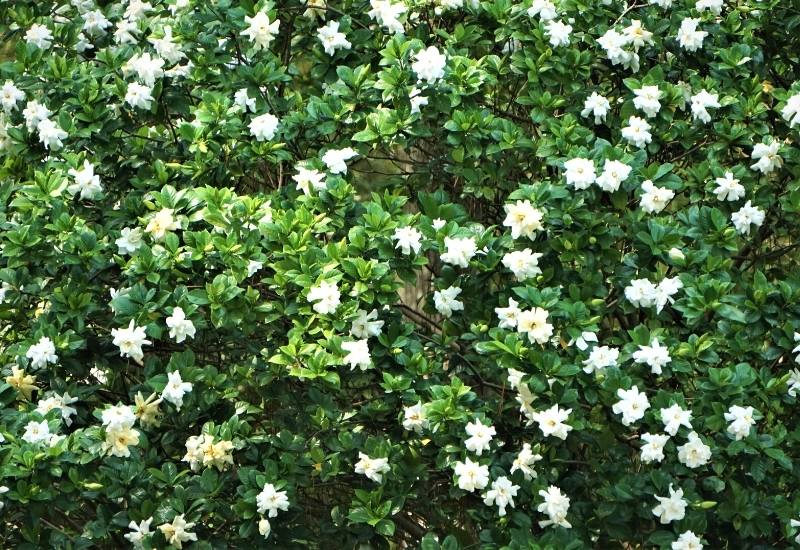
The ivory white rose like blooms of gardenia can bring light and purity to any shady corner in your garden. They can be 5 inches in diameter (12 cm) and they are always, well regal in their elegance and sculptural in their beauty.
The dark glossy foliage sets them off perfectly on the shrubs, where they can be free to give off their beautiful scent.
Maybe containers are better for this delicate and high maintenance plant, because unless you have the right type of soil, they will have serious problems growing and, above all, they may never bloom at all.
9: ‘The Lark Ascending’ English Shrub Rose (Rosa ‘The Lark Ascending’)
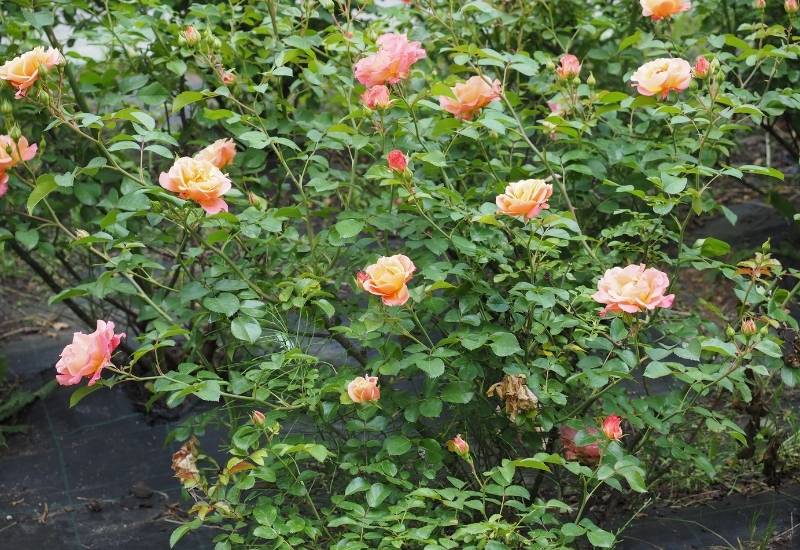
Surprise surprise, and English shrub rose for shade! There are a few actually, but we chose ‘The Lark Ascending’ for its beautiful cupped apricot semi double blooms that can be 4 inches across (10 cm) that keep coming from spring to fall with a light tea to myrrh aroma.
This English rose variety is a real sweet beauty, and it is also very disease resistant, which is always a plus with this plant, especially if you do not have lots of sunlight to offer. Its modest size makes it ideal for small gardens and containers too.
10: Summersweet (Clethra alnifolia)
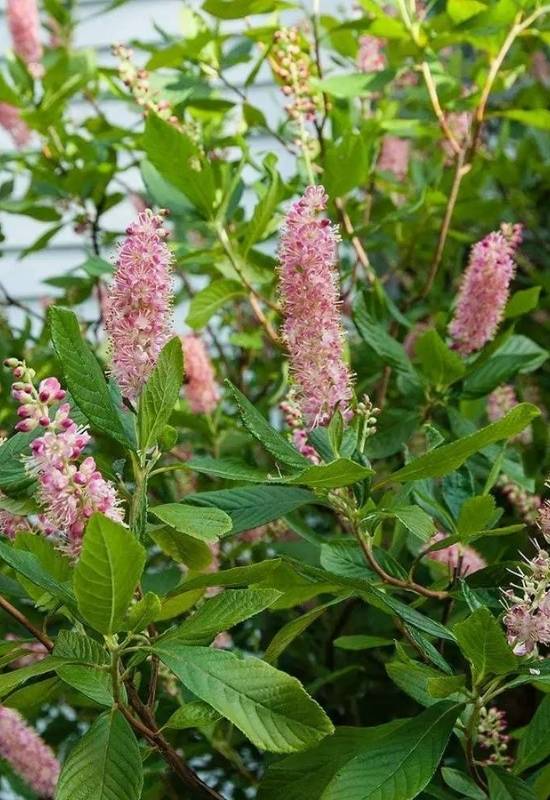
Summersweet is a low shrub with a spreading habit with spiky inflorescences that love to brighten up shady spots. These can be white or pink, and they are plentiful,
coming straight up from the lush foliage to attract hummingbirds, butterflies and bees to that corner if your garden and balcony where you have little, o pr even very little sunlight.
The leaves too grow upright, and they are mid green veined and elliptical in shape, but they turn gold in color in fall, for a final spectacle before they drop!
11: Mountain Laurel (Kalmia latifolia)
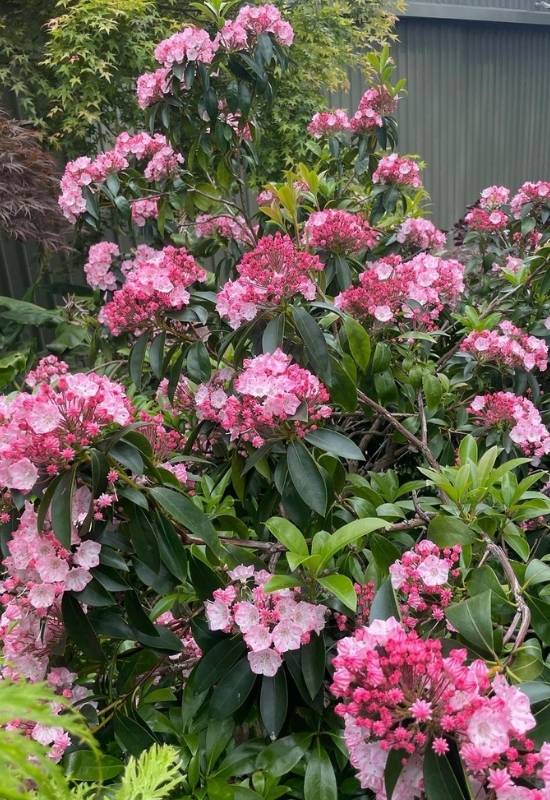
Mountain laurel is a shade loving shrub that has won the Cary Award thanks thanks to its original, light rose pink flowers and elegant foliage. The blooms are bell shaped with joint petals that form an almost perfect pentagon at the mouth.
The anthers are copper red, while there are also dark pink spots inside the blossoms. They will come in showy clusters from pink buds on the glossy, oval evergreen foliage, which turns purple brown in the cold months.
It is a fairly large shrub, so you can use it for big projects, and bring its vibrant presence and color where sunlight is scarce, even in cold regions!
12: Japanese Quince (Chaenomeles speciosa)
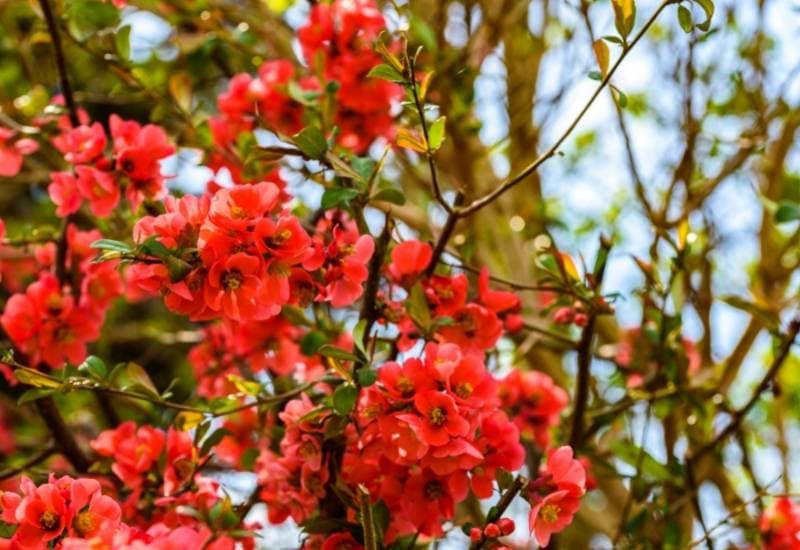
Japanese quince is a shrub that prefers shady places to fill with its many, round, showy flowers. These come in early spring on the almost barren black branches, forming clumps of white, orange, red, pink or even green flowers, as there are many varieties.
Some even have double blooms, and all are very generous with their amazing blossoms with an oriental feel to them.
2 inch (5 cm) yellow and shiny fruits follow and they stay on till fall, when you can pick them and eat them! The foliage is oval and mid green, forming a lovely glossy curtain from late spring to frost.
Blooms don’t end here. There will be more flowers in the following categories, some small and inconspicuous, but many will be quite showy, especially in the next group!
Shade Loving Climbing Shrubs
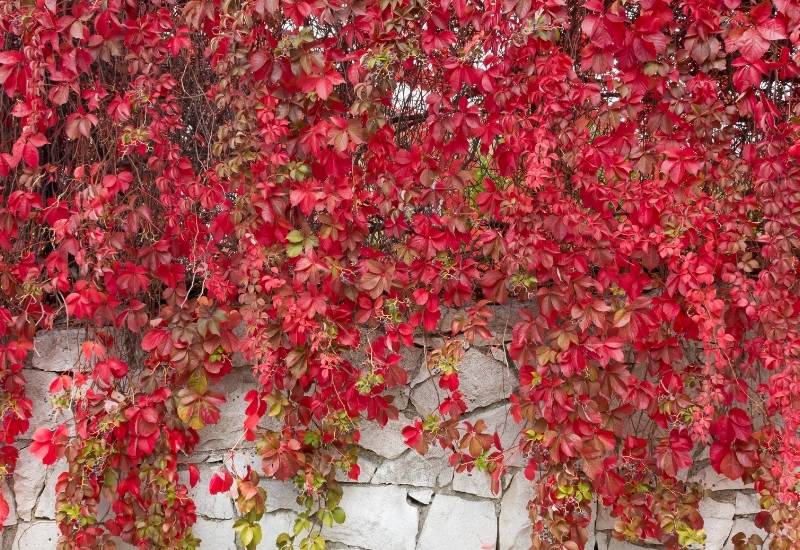
When you have a shady spot, growing bushy vines gives you that sense of… well, being in a natural forest, exotic or not, and climbers bring a sense of freshness, of breeze, of light but cool air…
Many climbers are partly shrubs, like roses, and the gardening effect is similar, so we have included a few.
Then again, many gazebos and pergolas do not get lots of light under them and shrubs, or better climbers that don’t mind some darkness become very useful indeed.
And here are the very best!
13: Clematis (Clematis spp.)
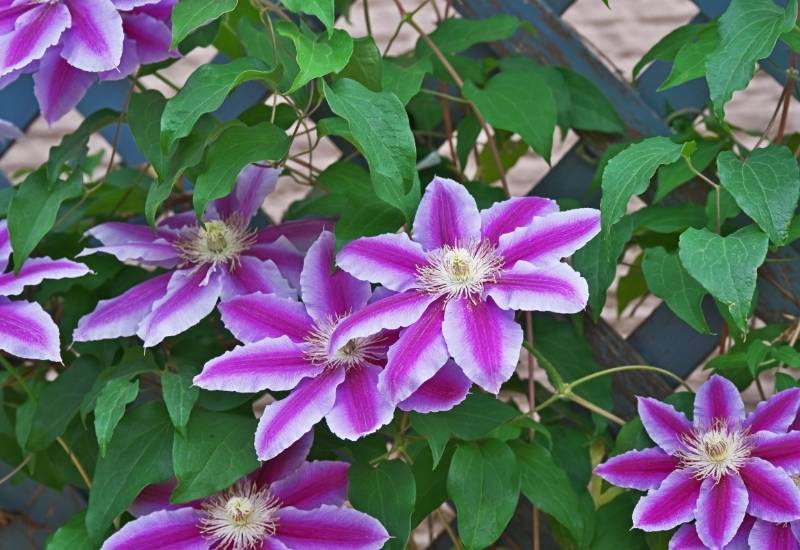
Clematis brings large, colorful and exotic looking flowers to trellises, walls, fences and even tree trunks in shady places.
The amazing colors of these large star shaped blooms excel in the strong pink, magenta to violet and purple tonalities, but there are white and light blue flowers too.
They can be 5 inches across (12 cm) and impossible to miss, even in the dark! The blossoms are showy and abundant, with early and late varieties, so you can have bright vitality and interest in places at different times of the year.
14: ‘Eden’ Climbing Rose (Rosa ‘Eden’)
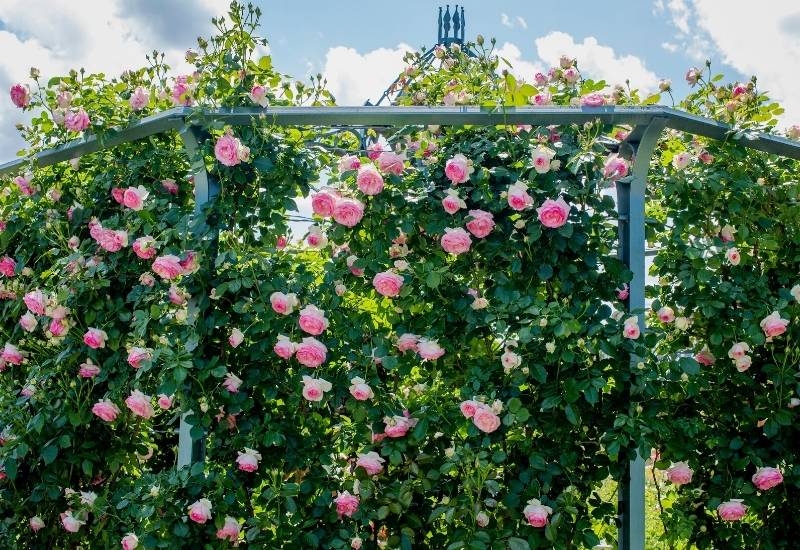
Among the rambling and climbing rose shrubs that like shade, we have chosen ‘Eden’ because it brings you a touch of the old world like few others.
The cupped blossoms can reach 4 inches across (10 cm), they have 70 petals and they display a range pink to cream shades that whisper “romance” and “English countryside”.
They will keep coming form months, with their sweet fragrance and nostalgic look. I forgot… this variety entered the Rose Hall of Fame of the World Federation of Rose Societies in 2006!
15: Trumpet Vine (Campsis radicans)
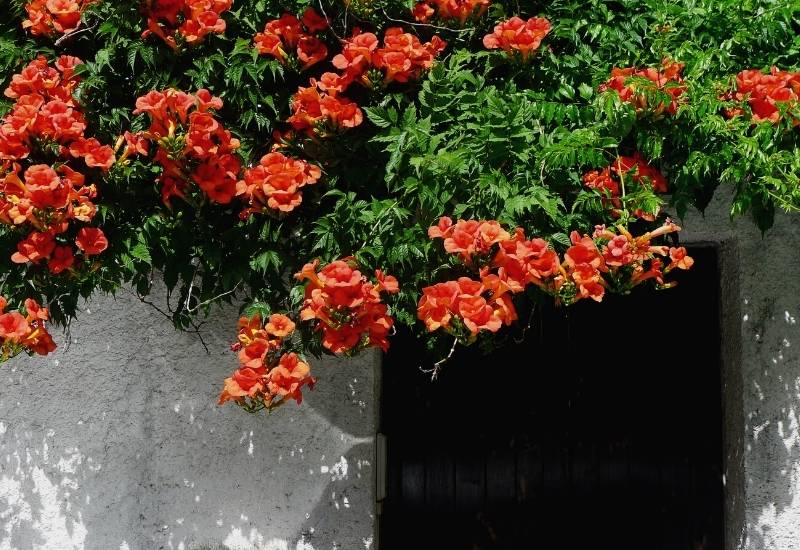
Trumpet shaped and bright orange flowers that point upward give this bushy climber its name: trumpet vine. They are 3 inches long (8 cm) and very abundant all through the summer season,
coming on very green and thinly textured foliage of pinnate leaves with equally green stems which makes the perfect shrubby backdrop to the beautiful blooms.
So you can bring a touch of the exotic and the Mediterranean to your garden, pergola or trellis even if sunlight is scare and if you live in temperate areas, like US central states or southern Canada! It can actually grow into a giant, so, perfect for poorly lit wall sides!
16: English Ivy (Hedera helix)
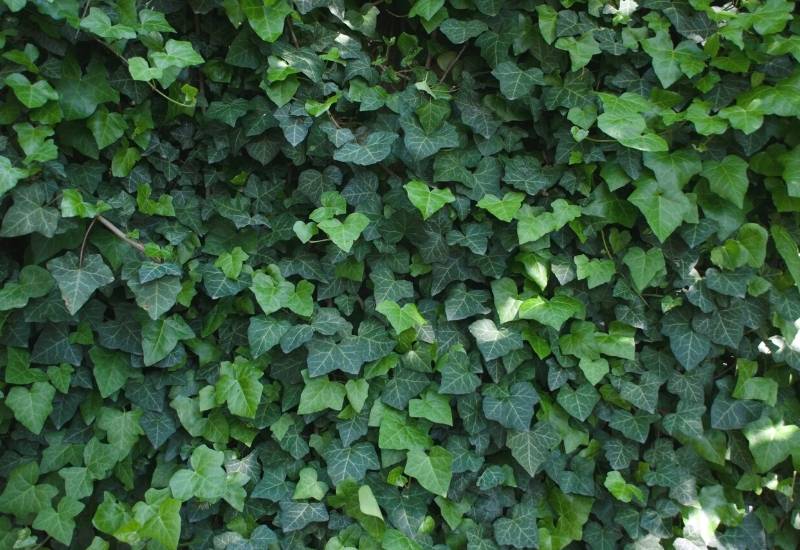
For a shade loving climber with a bushy effect, English ivy is perfect. It is not actually a shrub but a pure vine, but the effect is similar.
With its many pointed leaves that cover walls, columns, trellises or even tree trunks or statues, it is a classic, and it comes in many varieties, like ‘Needlepoint’ (with very deep lobes and pointed tips), ‘Anne Marie’ (white and dark green foliage) and ‘Goldchild’ (green and yellow leaves).
This is a plant you can even grow in full shade, and if you don’t like it going up, you can use it as ground cover.
17: California Lilac (Ceanothus spp.)
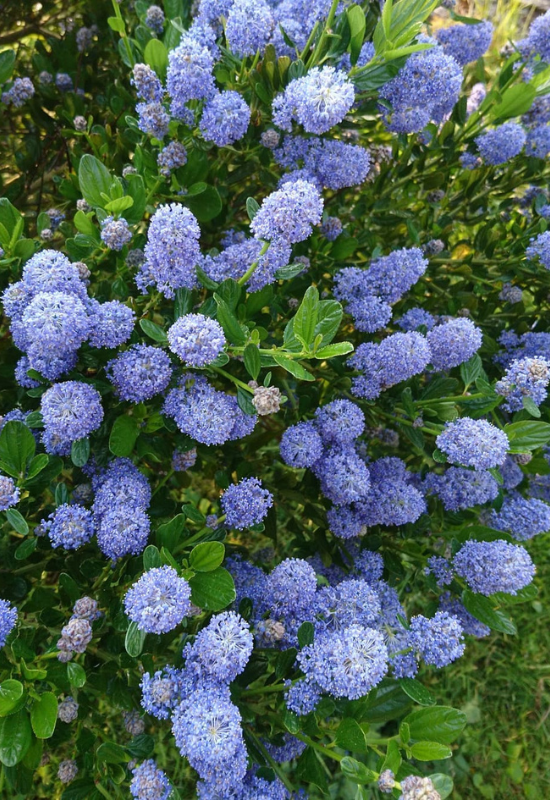
Shade loving California lilac is better classed as a “wall shrub” than an actual climber, but it serves similar functions in gardening, so here it is.
And it comes with massive blue blooms made up of myriad little flowers in large clusters that cover the whole shrub, and your wall, or fence, or you can use it to seal off the space between trees to create a sense of privacy in that fresh spot where the Sun comes only a few hours a day.
This bushy beauty has won the Award of Garden Merit by the Royal Horticultural Society, a guarantee of great decorative value!
18: Wall Cotoneaster (Cotoneaster horizontalis)
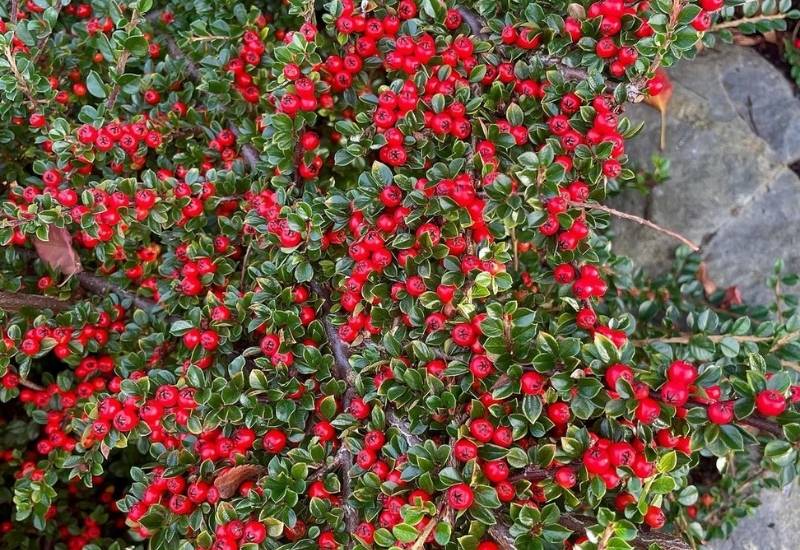
For that shady side of your hone where you want a shrub that clings to its side and gives you deep green and red vibes and an amazing pattern of branches… wall cotoneaster (or rock cotoneaster) is just perfect.
The fishbone branching of this plant is in itself very decorative, and with the regularly spaced, small and oval dark green leaves it adds a dimension… In spring, tiny pink and start shaped flowers will pop up between them.
Then, red round berries appear between the tiny leaves, and when they ripen and fall, the foliage itself becomes fiery red before it falls. In winter, the geometric and dark to purple branches are themselves a little spectacle!
So now you have some great plants to grow vertical walls, seal off unsightly sides and preserve the freshness and intimacy of you shady garden or terrace spaces. Next, we are looking at plants that keep the “green” all year round!
Shade Loving Evergreen Shrubs
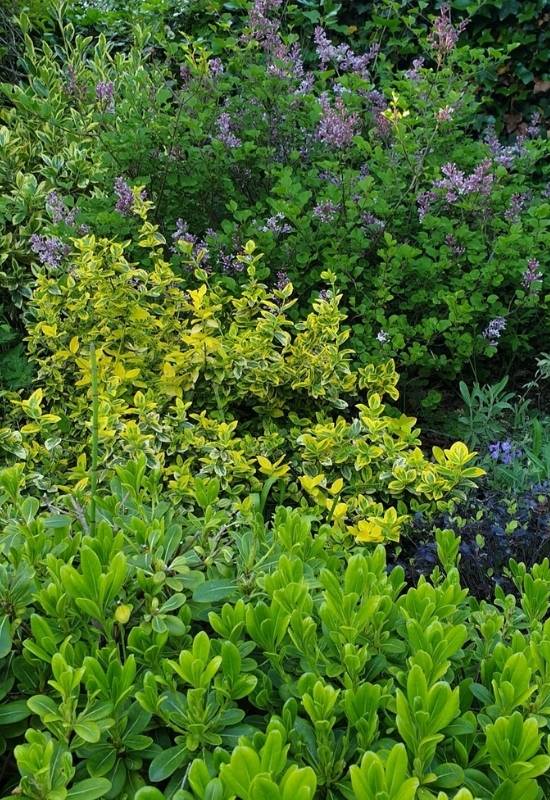
Evergreen shrubs never drop their foliage, so they can bring structure and consistency throughout the year to your shady spot in the garden or on your terrace.
Looking at a totally barren landscape is far too depressing, and you always need to plant some evergreens to keep the green theme going on, and to remind you that Nature is only asleep.
And guess what? We have some amazing ones for you!
19: Bay Laurel (Laurus nobilis)
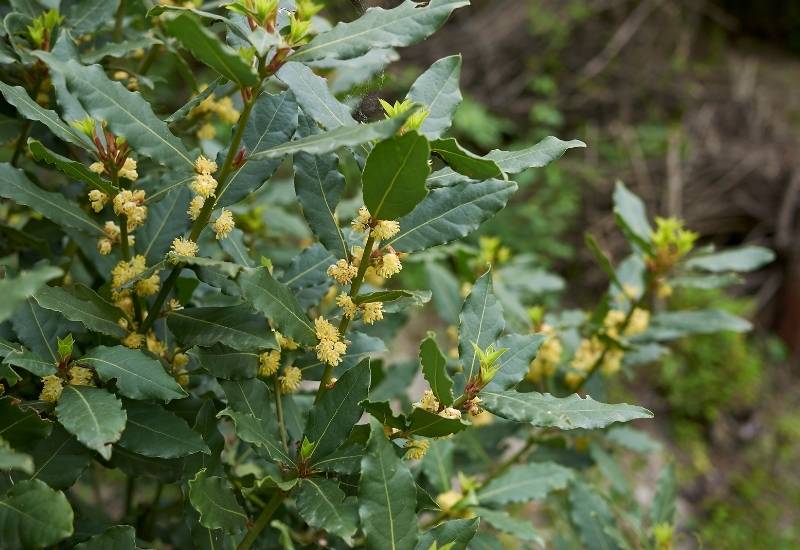
The bay leaves we use to cook come from a shade loving shrub with great decorative value to gardeners: the evergreen bay laurel!
These plants can be pruned and trained into trees and even used in topiary, thanks to the super glossy, long lasting, resistant mid green foliage! They have a compact habit, which makes them ideal for privacy and garden walls and rooms.
They are beautiful all year round, but male specimens will produce small but pretty yellow flowers in spring, then, female plant will grow dark purple berries for your enjoyment and that of birds!
20: ‘Blue Star’ Flakey Juniper (juniperus squamata ‘Blue Star’)
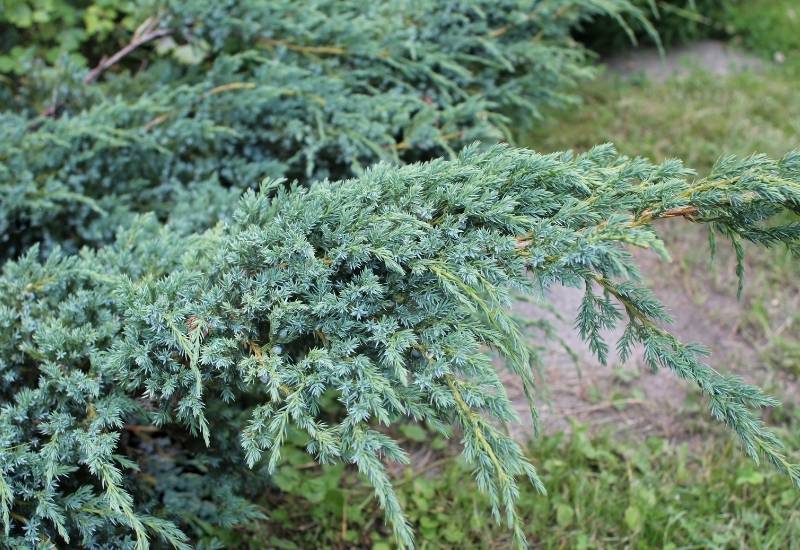
Blue star is an evergreen small shrub juniper that grows well in partial shade. Or shall we say “ever blue”? Yes, because the needles of this bush with a round habit are of a decided bright blue hue!
They look like little fountains of fresh water all year round, so sure you can see what a twist it can give to that poorly lit place, and it is small enough to live well in containers, on terraces, patios, under gazebos etc…
It so beautiful that it has received the most prestigious gardening prize in the whole world: the Award of Garden Merit by the Royal Horticultural Society.
21: ‘Goldy’ Wintercreeper (Euonymus fortunei ‘Goldy’)
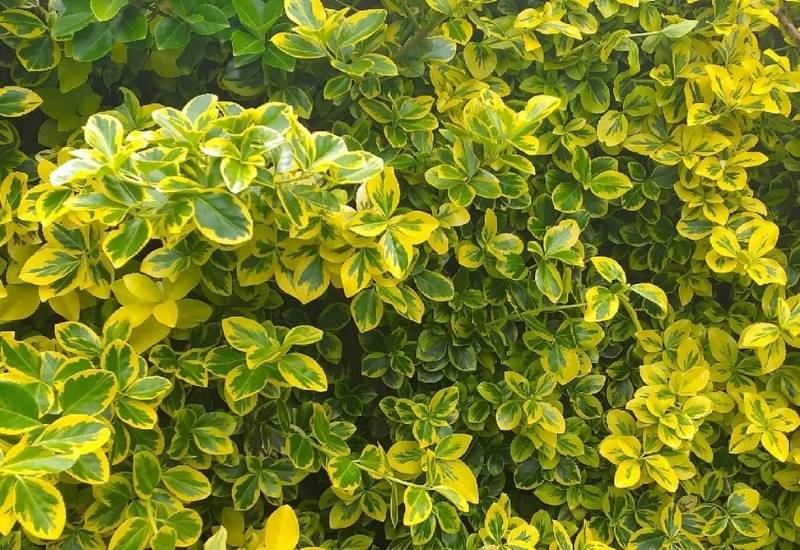
To bring light and color to a shady spot, evergreen shrub ‘Goldy Wintercreeper’ offers thick foliage of small oval and glossy, bright and chartreuse yellow leaves all year round.
These form a thick blanket that covers the whole round and beautiful small plant. And if you like other colors there are varieties of wintercreeper in white and green, ‘Emerald Gaiety’, yellow and green ‘Gold Spanish’ or pure bright green, like ‘Coloratus’.
This easy to grow and low maintenance bush is like one of those players that fill you with joy when all the others are tiered and spent, even if you didn’t notice him all through the match.
22: English Yew (Taxus baccata)
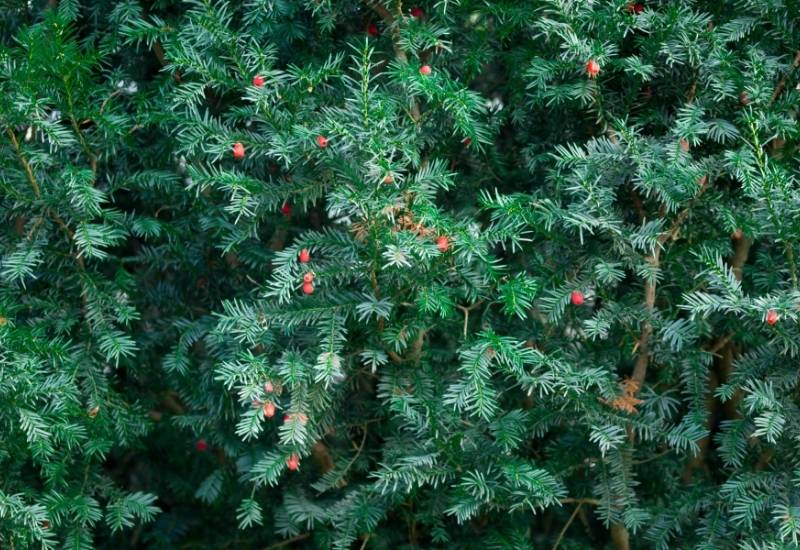
English yew is an evergreen shrub that can even grow in full shade! This classic conifer with soft and light green needles with a hint of gold,
upright branches and a fuzzy and fluffy look, growing into a kind of column, a bit like Cousin It from the Adams Family will not let you down even in the darkest corners of your terrace or balcony.
Male plants will also have coral red cones that look like berries, adding another twist to the beauty of this small bush. Its habit is very upright, with branches that point to the sky,
so it is ideal to bring a vertical dimension to that poorly lit area of your garden or terrace. Yes, because it does fit into a container too!
23: Japanese Holly (Ilex crenata)
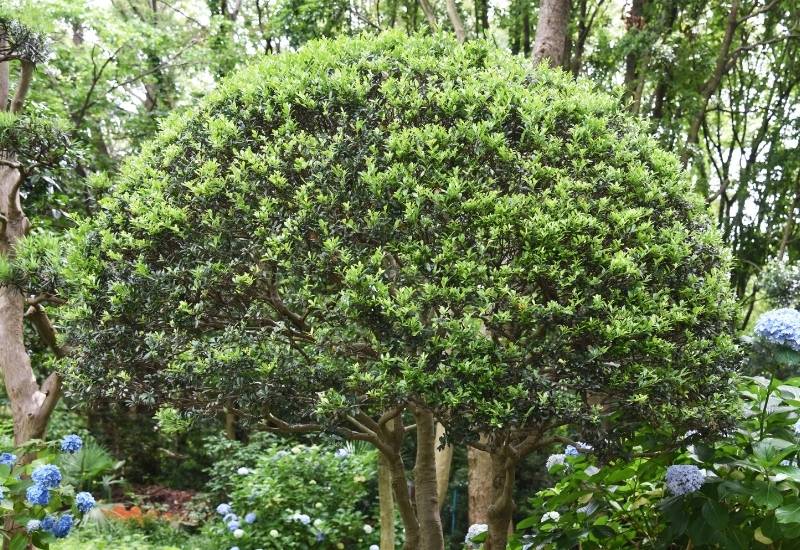
Japanese holly is a slow growing evergreen shrub of medium size that fits perfectly in the shade of taller trees, and it also adapts to wall side planting, to add green where it is needed.
And very green it is indeed, with thick foliage on a spectrum from light to almost olive, and an infinity of tiny, round and shiny leaves, thick and cute.
The very fine texture of this bush is admirable, and when the round, dark blue berries appear, they add dots of shiny interest to a very dense effect already.
It can be pruned into topiaries or even trained into a small tree, but it will be beautiful all year round, even in winter!
24: ‘Ferox Argentea’ English Holly (Ilex aquifolium ‘Ferox Argentea’)
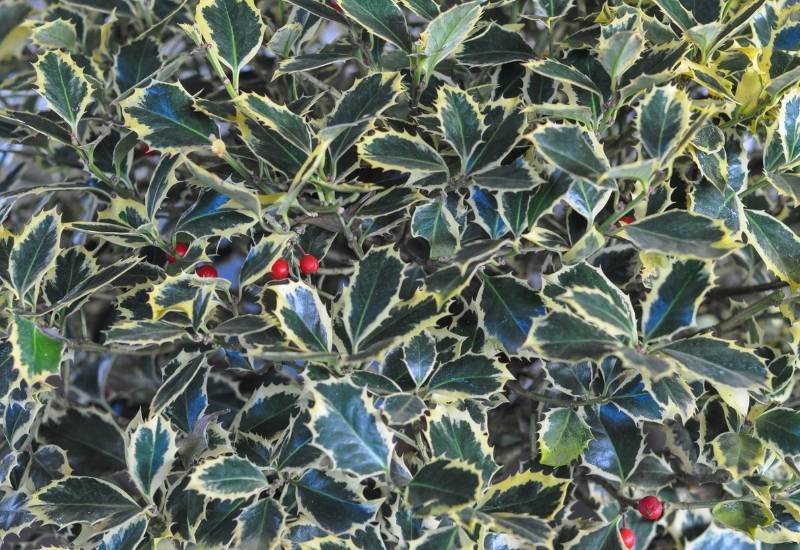
‘Ferox Argentea’ looks great in Christmas decorations and you can grow it as a shrub in partial shade, where it can work wonders. The spiky foliage is super glossy and and evergreen, with a very dark green center and cream yellow edges.
It is thick and lush, and a real strong but rebellious presence under trees or next to walls. The flowers appear in spring, they are white, abundant but small. They will give way to bright red berries that stay on all the way to the festive season.
The twigs themselves are of gardening interest, thanks to their purple color.This variety of English holly is a bright spectacle all year round! Maybe that’s why the Royal Horticultural Society has given it the Award of Garden Merit?
Shade Loving Deciduous Shrubs
Deciduous shrubs drop their foliage in winter, but they still add beauty, foliage and sometimes blooms as well to spots in the shade from spring to fall, and there are some real beauty.
In fact, these shrubs allow your garden or terrace to change through the seasons, so, while evergreens offer “stability and continuity”, deciduous bushy plants are better at giving you change, dynamics and a sense of progress throughout the year.
Have a look at what we have in store for you!
25: Tartarian Dogwood (Cornus alba ‘Sibirica’)
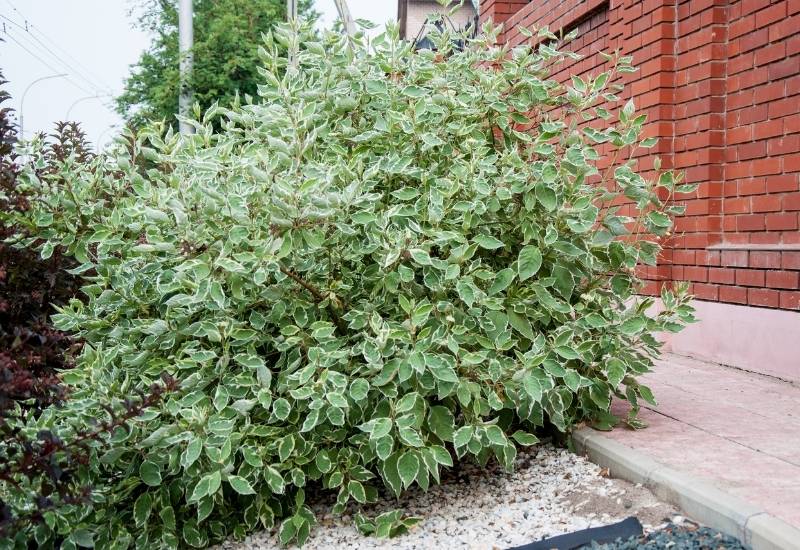
Ttartarian dogwood is a deciduous shrub that will bring color to your fresh corner in the shade with or without foliage on. In fact, the leaves are beautiful enough, broad, heat shaped, with deep veins and light green to copper in color.
Ir will also give you clusters of beautiful light solver blue berries late in the season. But it is at its best in winter, when the branches are naked.
They are of the most impressive ruby red color, and they look like stocks on fire with their upright habit! It is ideal for cold regions and it has received the famous Award of Garden Merit by the Royal Horticultural Society.
26: Elderberry (Sambucus racemosa)
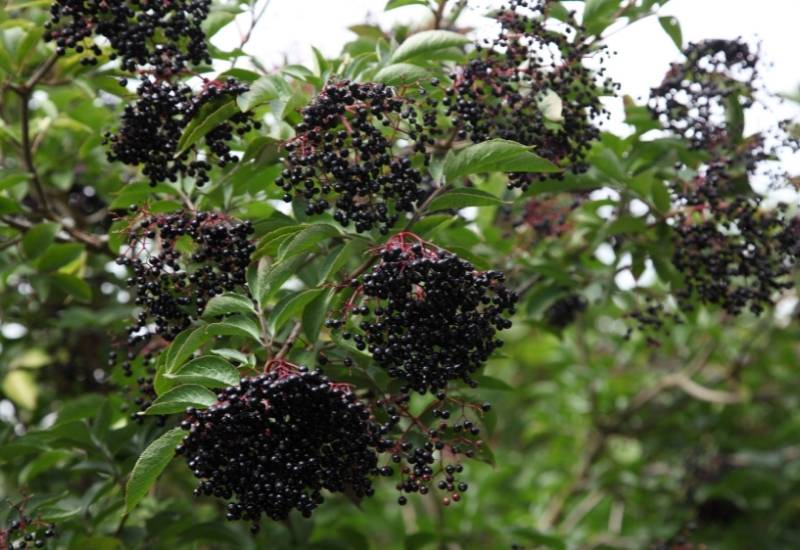
Elderberry is a perfect deciduous shrub for texture in shady places. The leaves are beautifully segmented, like fronds, and they are light green, but there are lime varieties too.
They often turn gold and red or purple in that fall, and they bring that sense of lush underbrush that fits so well in fresh corners under trees.
It will also give you loads of cream and star shaped flowers in spring and then lots of shiny red fruits that stay on till the late season, attracting birds to your garden.
The ‘Southern Gold’ cultivar has won the Award of Garden Merit by the Royal Horticultural Society.
27: ‘Henry’s Garnet’ Virginia Sweetspire (Itea virginica ‘Henry’s Garnet’)
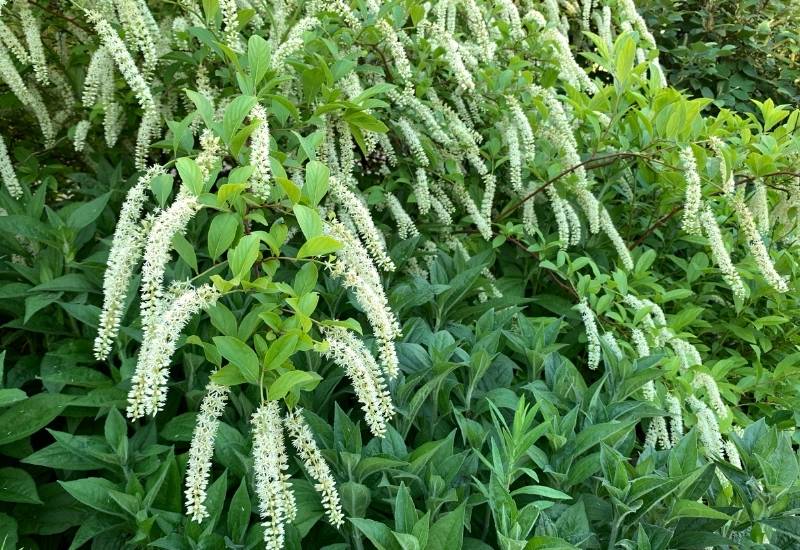
We gave chosen the cultivar ‘Henry’s Garnet’ of all the shade loving Virginia sweetspire varieties because… Like the others,
it has lush and broad and oval, glossy leaves of the brightest green on elegant and arching almost black stems.
These fill with plumes of fragrant white flowers from spring to summer, nodding and looking like bottle brushes.
But this very variety also turns deep red, on the bourbon shade, as soon as the cold season comes, passing first through pinks shades as well!
28: Arrowwood (Viburnum x bodnantense ‘Darwin’)
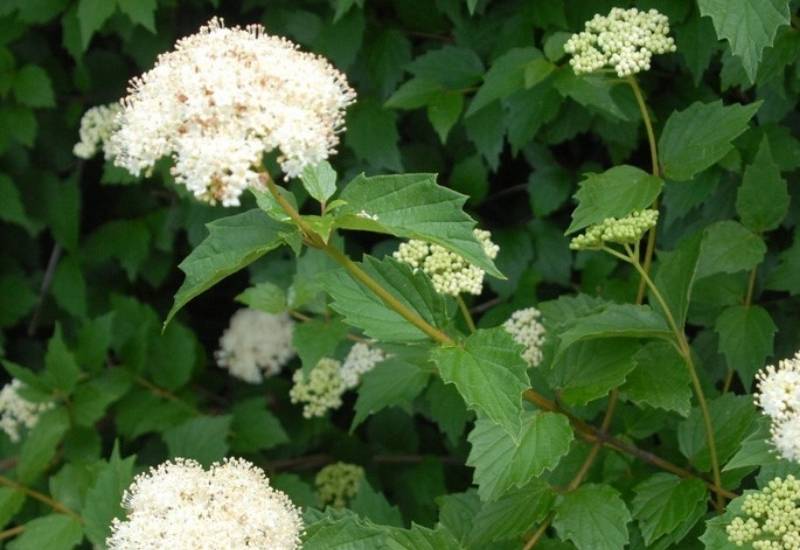
Arrowood is a deciduous shrub that likes shade and it starts its show in early spring. New, oval leaves come out in spring and they are bronze. Then the foliage turns green, and finally burgundy red before they fall.
But there is also the flower cycle, and it can vary; in cold countries, they start in winter and they continue till spring, while in hot countries they start in fall. The blooms are loads, pink, in cluster and very fragrant.
Yes, you get them in winter! And them the fruits, which start off bright red and end up black. What a display of colors for that sad and dark spot in your garden or on your terrace! You wonder why it was given the Award of Garden Merit by the Royal Horticultural Society…
29: Heavenly Bamboo (Nandina domestica)
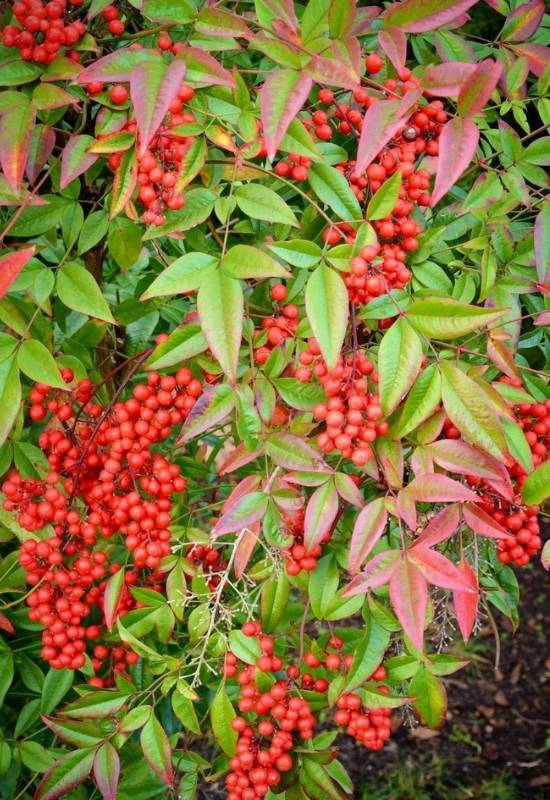
Heavenly bamboo is a deciduous shrub that’s ideal to bring vibrant colors to shady gardens and terraces. To be honest it is semi evergreen,
which means that it’s deciduous in temperate climates, but it will keep its foliage on in hot ones. The leaves come on long arching stems, and they are bright green during the year,
but they turn purple in fall. Panicles of flowers arch from the bush in spring, white and star shaped. Then they give way to clusters of bright red berries that keep you company till late in the season.
30: ‘Red Cascade’ Spindle (Euonymus eauropeaus ‘Red Cascade’)
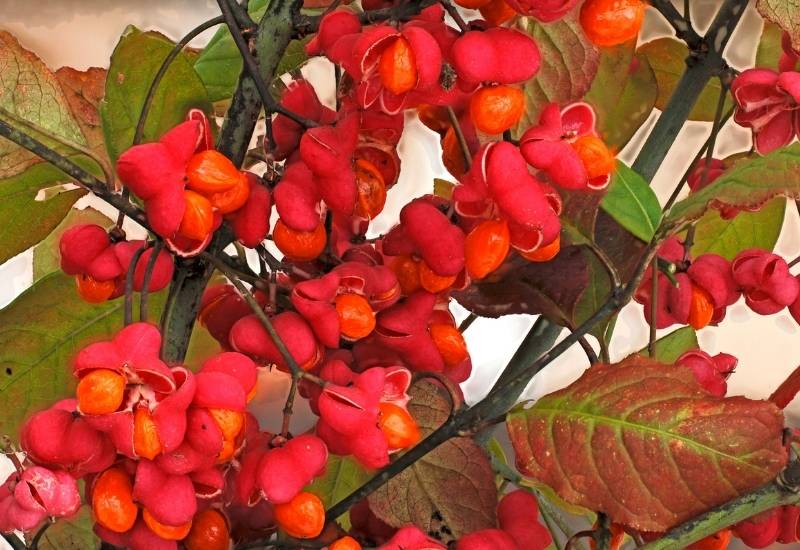
Your shady spot will never look the same with this bright deciduous shrub: ‘Red Cascade’ spindle. The leaves start off as green and oval in spring, then you get a profusion of pink red and nodding flowers that hang among them form months, from spring to summer.
And once they have withered, you get loads of capsules with orange seeds that open for extra color, and to attract birds in search of food in the late season.
But this is not the end of the show! The foliage turns into the deepest purple red in fall, before they fall. But the fruits will still be on, and little winged visitors will still be coming for lunch!
No More Darkness In Your Shady Garden With Shade Loving Shrubs!
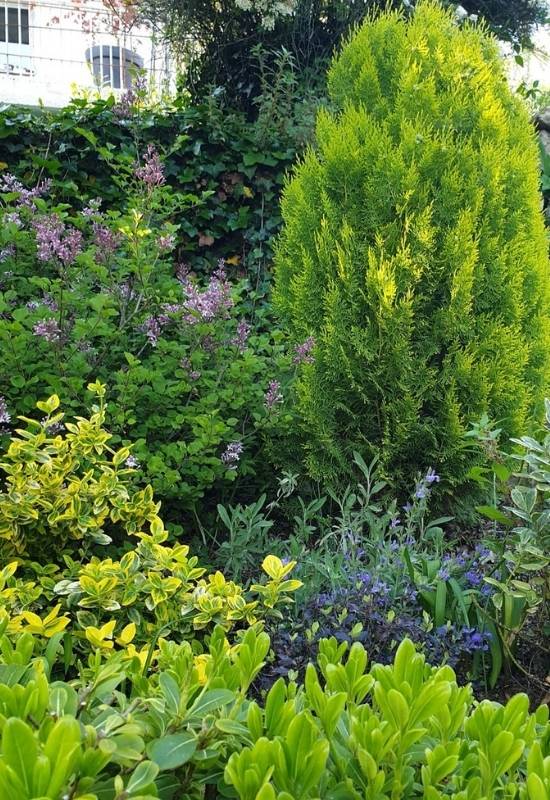
Just think about how many colors we have met in this article!
With leaves, blooms and even branches that add beauty and life to shady corners, evergreens, climbers, deciduous and flowering bushy plants are not just great help if you have a spot where sunlight is scarce. They are a must!

Written By
Amber Noyes
Amber Noyes was born and raised in a suburban California town, San Mateo. She holds a master’s degree in horticulture from the University of California as well as a BS in Biology from the University of San Francisco. With experience working on an organic farm, water conservation research, farmers’ markets, and plant nursery, she understands what makes plants thrive and how we can better understand the connection between microclimate and plant health. When she’s not on the land, Amber loves informing people of new ideas/things related to gardening, especially organic gardening, houseplants, and growing plants in a small space.
